 |
HP OpenVMS systems documentation |
| Previous | Contents | Index |
Signaling a condition value causes systems to pass control to a special subprogram called a condition handler. The operating system invokes a default condition handler unless you have established your own. The default condition handler displays the associated error message and continues or, if the error is a severe error, terminates program execution.
The signal argument vector contains information describing the nature of the hardware or software condition. Figure 9-6 illustrates the open-ended structure of the signal argument vector, which can be from 3 to 257 longwords in length.
The format of the signal argument array and the data it returns is the same on VAX systems, Alpha systems, and I64 systems with the exception of the processor status (PS) returned on Alpha systems and I64 and the processor status longword (PSL) returned on VAX systems. On Alpha and I64 systems, it is the low-order 32 bits of the PS. Note that the PS in the signal arrays on I64 systems is fabricated.
On Alpha systems, CHF$IS_SIG_ARGS and CHF$IS_SIG_NAME are aliases for CHF$L_SIG_ARGS and CHF$L_SIG_NAME, as shown in Figure 9-6, and the PSL field for VAX systems is the processor status (PS) field for Alpha systems.
Figure 9-6 Format of the Signal Argument Vector
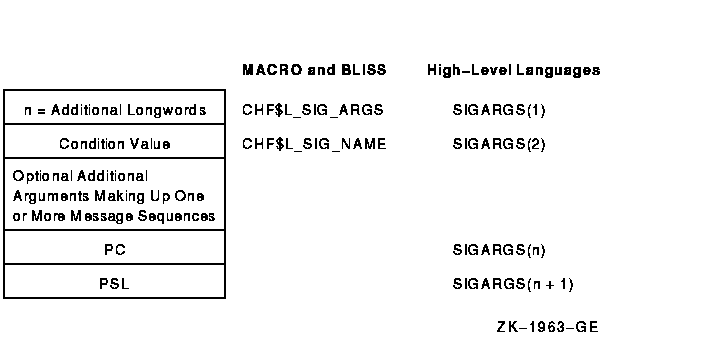
SIGARGS(1)
An unsigned integer (n) designating the number of longwords that follow in the vector, not counting the first, including PC and PSL. (On Alpha systems, the value used for the PSL is the low-order half of the Alpha processor status [PS] register. For I64 systems the PS is also used, but the PS is fabricated.) For example, the first entry of a 4-longword vector would contain a 3.SIGARGS(2)
This argument is a 32-bit value that uniquely identifies a hardware or software exception condition. The format of the condition code, which is the same for VAX systems, Alpha systems, and I64 systems, is shown and described in Figure 9-3. However, Alpha systems do not support every condition returned on VAX systems, and Alpha systems define several new conditions that cannot be returned on VAX systems. Some Alpha conditions exist on I64, some Alpha conditions are not appropriate for I64 and there are some new I64 conditions. Table 9-3 lists VAX system condition codes that cannot be returned on Alpha and I64 systems.If more than one message is associated with the error, this is the condition value of the first message. Handlers should always check whether the condition is the one that they expect by examining the STS$V_COND_ID field of the condition value (bits <27:3>). Bits <2:0> are the severity field. Bits <31:28> are control bits; they may have been changed by an intervening handler and so should not be included in the comparison. You can use the RTL routine LIB$MATCH_COND to match the correct fields. If the condition is not expected, the handler should resignal by returning false (bit <0> = 0). The possible exception conditions and their symbolic definitions are listed in Table 9-1.
SIGARGS(3 to n --1)
Optional arguments that provide additional information about the condition. These arguments consist of one or more message sequences. The format of the message description varies depending on the type of message being signaled. For more information, see the SYS$PUTMSG description in the HP OpenVMS System Services Reference Manual. The format of a message sequence is described in Section 9.11.SIGARGS(n)
The program counter (PC) of the next instruction to be executed if any handler (including the system-supplied handlers) returns with the status SS$_CONTINUE. For hardware faults, the PC is that of the instruction that caused the fault. For hardware traps, the PC is that of the instruction following the one that caused the trap. The error generated by LIB$SIGNAL is a trap. For conditions signaled by calling LIB$SIGNAL or LIB$STOP, the PC is the location following the CALLS or CALLG instruction. See the VAX Architecture Reference Manual, Alpha Architecture Reference Manual, or the Intel® Itanium® Architecture Software Developer's Manual for a detailed description of faults and traps.SIGARGS(n+1)
On VAX systems the processor status longword (PSL), or on Alpha and I64 systems the processor status (PS) register (which is fabricated on I64), of the program at the time that the condition was signaled.For information about the PSL on VAX systems, and the PS on Alpha systems, see the VAX Architecture Reference Manual and the Alpha Architecture Reference Manual.
LIB$SIGNAL and LIB$STOP copy the variable-length argument list passed by the caller. Then, before calling a condition handler, they append the PC and PSL (or on Alpha and I64 systems the processor status (PS) register, which is fabricatred on I64) entries to the end of the list. |
The formats for some conditions signaled by the operating system and the run-time library are shown in Figure 9-7 and Figure 9-8. These formats are the same on VAX systems and Alpha systems, except for the PSL, or on Alpha and I64 systems, the PS register (which is fabricated on I64).
Figure 9-7 Signal Argument Vector for the Reserved Operand Error Conditions
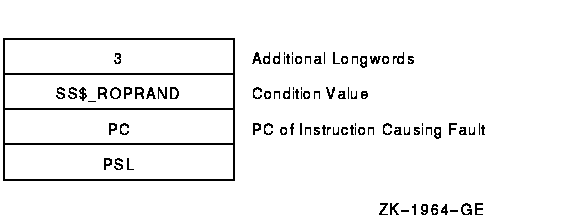
Figure 9-8 Signal Argument Vector for RTL Mathematics Routine Errors
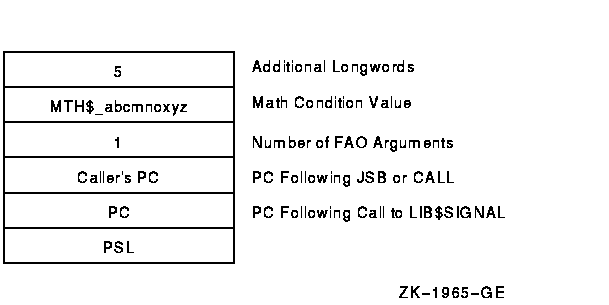
The caller's PC is the PC following the calling program's JSB or CALL
to the mathematics routine that detected the error. The PC is that
following the call to LIB$SIGNAL.
9.8.3 VAX Mechanism Argument Vector (VAX Only)
On VAX systems, the mechanism argument vector is a 5-longword vector that contains all of the information describing the state of the process at the time of the hardware or software signaled condition. Figure 9-9 illustrates a mechanism argument vector for VAX systems.
Figure 9-9 Format of a VAX Mechanism Argument Vector
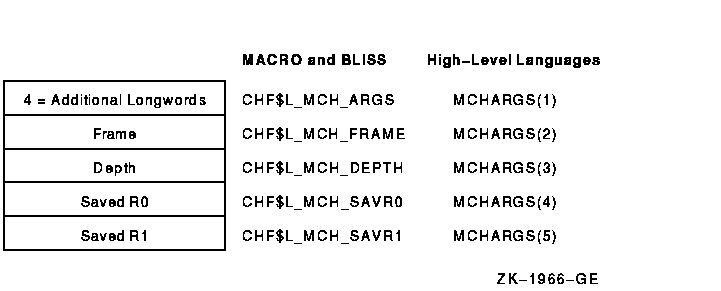
MCHARGS(1)
An unsigned integer indicating the number of longwords that follow, not counting the first, in the vector. Currently, this number is always 4.MCHARGS(2)
The address of the stack frame of the routine that established the handler being called. You can use this address as a base from which to reference the local stack-allocated storage of the establisher, as long as the restrictions on the handler's use of storage are observed. For example, if the call stack is as shown in Figure 9-4, this argument points to the call frame for procedure A.You can use this value to display local variables in the procedure that established the condition handler if the variables are at known offsets from the frame pointer (FP) of the procedure.
MCHARGS(3)
The stack depth, which is the number of stack frames between the establisher of the condition handler and the frame in which the condition was signaled. To ensure that calls to LIB$SIGNAL and LIB$STOP appear as similar as possible to hardware exception conditions, the call to LIB$SIGNAL or LIB$STOP is not included in the depth.If the routine that contained the hardware exception condition or that called LIB$SIGNAL or LIB$STOP also handled the exception condition, then the depth is zero; if the exception condition occurred in a called routine and its caller handled the exception condition, then the depth is 1. If a system service signals an exception condition, a handler established by the immediate caller is also entered with a depth of 1.
The following table shows the stack depths for the establishers of condition handlers:
Depth Meaning --3 Condition handler was established in the last-chance exception vector. --2 Condition handler was established in the primary exception vector. --1 Condition handler was established in the secondary exception vector. 0 Condition handler was established by the frame that was active when the exception occurred. 1 Condition handler was established by the caller of the frame that was active when the exception occurred. 2 Condition handler was established by the caller of the caller of the frame that was active when the exception occurred. . . . For example, if the call stack is as shown in Figure 9-4, the depth argument passed to handler A would have a value of 2.
The condition handler can use this argument to determine whether to handle the condition. For example, the handler might not want to handle the condition if the exception that caused the condition did not occur in the establisher frame.
MCHARGS(4) and MCHARGS(5)
Copies of the contents of registers R0 and R1 at the time of the exception condition or the call to LIB$SIGNAL or LIB$STOP. When execution continues or a stack unwind occurs, these values are restored to R0 and R1. Thus, a handler can modify these values to change the function value returned to a caller.
On Alpha systems, the mechanism array returns much the same data as it does on VAX systems, though its format is changed. The mechanism array returned on Alpha systems preserves the contents of a larger set of integer scratch registers as well as the Alpha floating-point scratch registers. In addition, because Alpha registers are 64 bits long, the mechanism array is constructed of quadwords (64 bits), not longwords (32 bits) as it is on VAX systems. Figure 9-10 shows the format of the mechanism array on Alpha systems.
Figure 9-10 Mechanism Array on Alpha Systems

Table 9-12 describes the arguments in the mechanism array.
| Argument | Description |
|---|---|
| CHF$IS_MCH_ARGS | Represents the number of quadwords in the mechanism array, not counting the argument count quadword. (The value contained in this argument is always 43.) |
| CHF$IS_MCH_FLAGS |
Flag bits <63:0> for related argument mechanism information
defined as follows for CHF$V_FPREGS:
Bit <0>: When set, the process has already performed a floating-point operation and the floating-point registers stored in this structure are valid. If this bit is clear, the process has not yet performed any floating-point operations, and the values in the floating-point register slots in this structure are unpredictable. |
| CHF$PH_MCH_FRAME | The frame pointer (FP) in the procedure context of the establisher. |
| CHF$IS_MCH_DEPTH | Positive count of the number of procedure activation stack frames between the frame in which the exception occurred and the frame depth that established the handler being called. |
| CHF$PS_MCH_DADDR | Address of the handler data quadword if the exception handler data field is present (as indicated by PDSC.FLAGS.HANDLER_DATA_VALID); otherwise, contains zero. |
| CHF$PH_MCH_ESF_ADDR | Address of the exception stack frame (see the Alpha Architecture Reference Manual). |
| CHF$PH_MCH_SIG_ADDR | Address of the signal array. The signal array is a 32-bit (longword) array. |
| CHF$IH_MCH_SAVR nn | A copy of the saved integer registers at the time of the exception. The following registers are saved: R0, R1, and R16--R28. Registers R2--R15 are implicitly saved in the call chain. |
| CHF$FM_MCH_SAVF nn | A copy of the saved floating-point registers at the time of the exception or may have unpredictable data as described in CHF$IS_MCH_FLAGS. If the floating-point register fields are valid, the following registers are saved: F0, F1, and F10--F30. Registers F2--F9 are implicitly saved in the call chain. |
For more information and recommendations about using the mechanism
argument vector on Alpha systems, see Migrating to an OpenVMS AXP System: Recompiling and Relinking Applications. Note that this
manual has been archived but is available on the OpenVMS Documentation
CD-ROM.
9.8.5 I64 Mechanism Vector Format
On I64 systems, the 64-bit-wide mechanism array is the argument mechanism in the handler call. The array is shown in Figure 9-11.
The CHF$IH_MCH_RETVAL and CHF$FH_MCH_RETVAL2 quadwords save the state of registers R8 and R9 at the time of the call to LIB$SIGNAL or LIB$STOP. The CHF$FH_MCH_RETVAL_FLOAT, CHF$FH_MCH_RETVAL2_FLOAT, and CHF$FH_MCH_SAVFnn octawords save the state of the floating-point registers at the time of the call to LIB$SIGNAL or LIB$STOP. If not modified by a handler during CHF processing (as described below), these values will become the values of those registers after completion of CHF processing (either by continuation or by unwinding).
The only supported method for modifying return values in a procedure's invocation context (CHF$IH_MCH_RETVAL, CHF$IH_MCH_RETVAL2, CHF$FH_MCH_RETVAL_FLOAT, CHF$FH_MCH_RETVAL2_FLOAT) is by using routine SYS$SET_RETURN_VALUE. The only supported method for modifying all other registers in a procedure invocation context is by using routine LIB$I64_PUT_INVO_REGISTERS, as described in the HP OpenVMS Calling Standard.
Figure 9-11 I64 Mechanism Vector Format
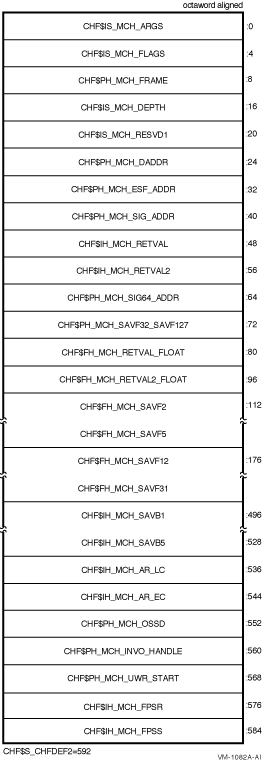
| Field Name | Contents | ||||
|---|---|---|---|---|---|
| CHF$IS_MCH_ARGS | Count of quadwords in this array starting from the next quadword, CHF$PH_MCH_FRAME (not counting the first quadword that contains this longword). This value is 71 if CHF$V_FPREGS_VALID is clear, and 263 if CHF$V_FPREGS_VALID is set. | ||||
| CHF$IS_MCH_FLAGS |
Flag bits <31:0> for related argument-mechanism information
defined as follows:
|
||||
| CHF$PH_MCH_FRAME | Contains the previous stack pointer, or PSP (the value of the SP at procedure entry) for the procedure context of the establisher, as described in HP OpenVMS Calling Standard. | ||||
| CHF$IS_MCH_DEPTH | Positive count of the number of procedure activation stack frames between the frame in which the exception occurred and the frame depth that established the handler being called, as described in the HP OpenVMS Calling Standard. | ||||
| CHF$IS_MCH_RESVD1 | Reserved to HP. | ||||
| CHF$PH_MCH_DADDR | Address of the handler data quadword (start of the Language Specific Data area, LSDA, see the HP OpenVMS Calling Standard) if the exception-handler data field is present in the unwind information block (as indicated by OSSD$V_HANDLER_DATA_VALID); otherwise, contains 0. | ||||
| CHF$PH_MCH_ESF_ADDR | Address of the exception stack frame. | ||||
| CHF$PH_MCH_SIG_ADDR | Address of the 32-bit form of signal array. This array is a 32-bit wide (longword) array. This is the same array that is passed to a handler as the signal argument vector. | ||||
| CHF$IS_MCH_RETVAL | Contains a copy of R8 at the time of the exception. | ||||
| CHF$IS_MCH_RETVAL2 | Contains a copy of R9 at the time of the exception. | ||||
| CHF$PH_MCH_SIG64_ADDR | Address of the 64-bit form of signal array. This array is a 64-bit wide (quadword) array. | ||||
| CHF$FH_MCH_SAVF32_SAVF127 | Address of the extension to the mechanism array that contains copies of F32-F127 at the time of the exception. | ||||
| CHF$IS_MCH_RETVAL_FLOAT | Contains a copy of F8 at the time of the exception. | ||||
| CHF$IS_MCH_RETVAL2_FLOAT | Contains a copy of F9 at the time of the exception. | ||||
| CHF$FH_MCH_SAVF nn | Contain copies of floating-point registers F2-F5 and F12-F31. Registers F6-F7 and F10-F11 are implicitly saved in the exception frame. | ||||
| CHF$FH_MCH_SAVB nn | Contains copies of branch registers B1-B5 at the time of the exception. | ||||
| CHF$FH_MCH_AR_LC | Contains a copy of the Loop Count Register (AR65) at the time of the exception. | ||||
| CHF$FH_MCH_AR_EC | Contains a copy of the Epilog Count Register (AR66) at the time of the exception. | ||||
| CHF$PH_MCH_OSSD | Address of the operating system-specific data area. | ||||
| CHF$PH_MCH_INVO_HANDLE | Contains the invocation handle of the procedure context of the establisher (See the HP OpenVMS Calling Standard.) | ||||
| CHF$PH_MCH_UWR_START | Address of the unwind region. |
A signal is said to be active until the routine that signaled regains control or until the stack is unwound or the image exits. A second signal can occur while a condition handler or a routine it has called is executing. This situation is called multiple active signals or multiple exception conditions. When this situation occurs, the stack scan is not performed in the usual way. Instead, the frames that were searched while processing all of the previous exception conditions are skipped when the current exception condition is processed. This is done in order to avoid recursively reentering a routine that is not reentrant. For example, Fortran code typically is not recursively reentrant. If a Fortran handler were called while another activation of that handler was still going, the results would be unpredictable.
A second exception may occur while a condition handler or a procedure that it has called is still executing. In this case, when the exception dispatcher searches for a condition handler, it skips the frames that were searched to locate the first handler.
The search for a second handler terminates in the same manner as the initial search, as described in Section 9.6.
If the SYS$UNWIND system service is issued by the second active condition handler, the depth of the unwind is determined according to the same rules followed in the exception dispatcher's search of the stack: all frames that were searched for the first condition handler are skipped.
Primary and secondary vectored handlers, on the other hand, are always entered when an exception occurs.
If an exception occurs during the execution of a handler that was established in the primary or secondary exception vector, that handler must handle the additional condition. Failure to do so correctly might result in a recursive exception loop in which the vectored handler is repeatedly called until the user stack is exhausted.
The modified search routine is best illustrated with an example. Assume the following calling sequence:
Figure 9-12 Stack After Second Exception Condition Is Signaled
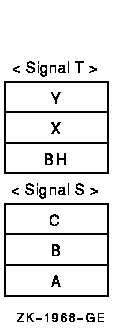
YH
XH
BHH (the handler for routine B's handler)
AH
Because of the possibility of multiple active signals, you should be careful if you use an exception vector to establish a condition handler. Vectored handlers are called, not skipped, each time an exception occurs.
| Previous | Next | Contents | Index |